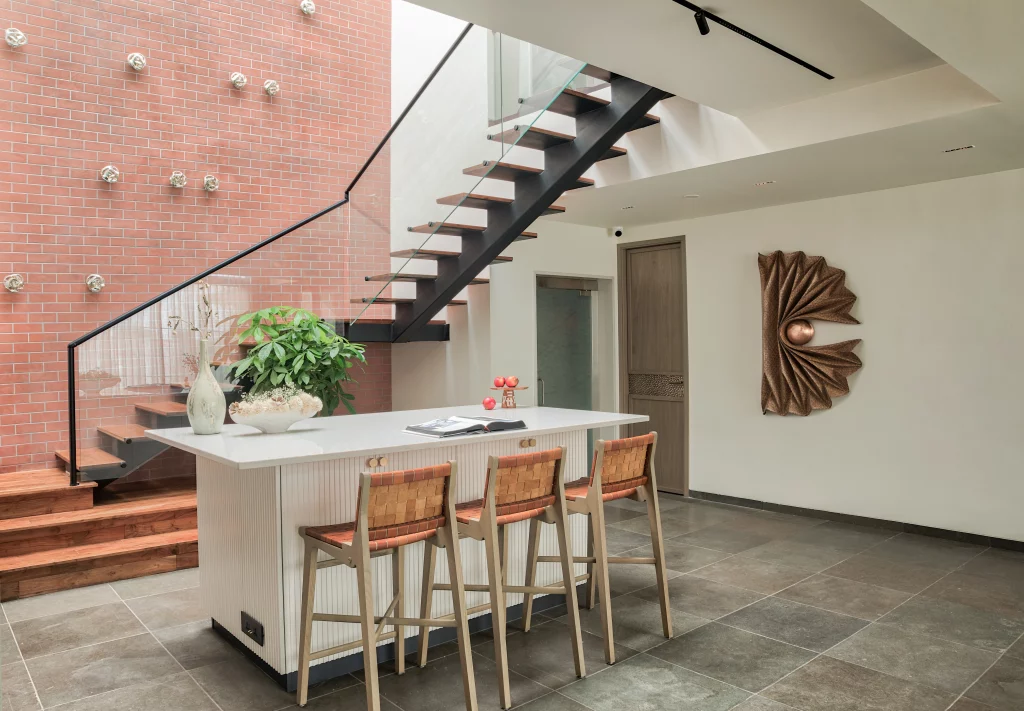(November 14, 2025) For Hyderabad-based designer Meghana Nimmagadda, creativity has always found its rhythm within structure. A BITS Pilani, Dubai engineer turned Pratt Institute, New York design graduate, she embodies a global sensibility rooted in Indian values.Her journey from the logic of engineering to the poetry of interior design reflects a rare blend of analytical clarity and emotional intelligence. As the founder of award-winning interior design studio, Designtales, she has built a practice defined by precision, feeling, and quiet confidence, one that speaks through spaces that tell human stories.
“I’ve always believed that creativity doesn’t have to come from chaos; it can emerge beautifully from discipline,” she says. That belief, shaped early in life, continues to guide her work and philosophy today.
View this post on Instagram
Creativity from an early age
Meghana was brought up in Hyderabad, in a family where simplicity and structure went hand in hand. With her grandfather having served in the Indian Army, discipline was a constant presence at home. “We weren’t raised to chase extravagance, but to value routine, respect time, and take responsibility,” she reflects.
That environment, she says, shaped her profoundly. As a child, she followed a structured routine, something that taught her that creativity could coexist with order. It also instilled a quiet resilience that would later serve her as both designer and entrepreneur. “I thrive in systems and structure, and that’s become a strong pillar in the way I run my practice today,” she explains.
Engineering the path to design
Although design was always her calling, Meghana began her academic journey in engineering at BITS Pilani, Dubai. Like many Indian students, she first followed the pragmatic path her parents encouraged. “My parents wanted me to complete engineering first, with the understanding that I could pursue whatever I wanted after that,” she says. In retrospect, she considers that detour a gift.
“Engineering gave me the structure, logic, and discipline that now form the backbone of how I run my studio,” she shares. Her technical background, she believes, sharpened her problem-solving abilities and taught her to think rationally, qualities that now balance her creative intuition.
When she moved to New York to pursue a Master’s in Interior Design from Pratt Institute, everything clicked into place. She discovered a world where creativity met systems, where her analytical and artistic sensibilities could work in tandem.

Coming home to create
After nearly eight years abroad, Meghana returned to Hyderabad in 2016 with a clear sense of purpose. “I couldn’t wait to start my own studio,” she says. “For me, it wasn’t just about starting a business; it was about finding myself, both as a person and as a designer.”
That journey of self-discovery became the foundation for Designtales, her multidisciplinary design practice. “Designtales is an extension of my inner world, my values, and the stories I want to tell,” she says. Over the years, her firm has become known for its refined aesthetic, storytelling-led approach, and deep attention to detail: qualities that reflect her personal ethos of thoughtful design.
One of Meghana’s earliest and most formative experiences was designing her own apartment. It became an unexpected masterclass in empathy and process. “Playing both client and designer helped me understand the nuances of what clients truly expect, not just from the design, but from the entire experience,” she says.
That project taught her that good design is only one part of a larger equation. “What matters equally is the service, the communication, and the clarity we bring to the journey,” she explains. The experience pushed her to create systems that made the creative process as seamless as the final outcome: something she now applies to every project she undertakes.
Balancing vision and function
Design, Meghana says, is “a constant dance between listening and guiding.” Clients often come with strong aesthetic preferences or emotional attachments to certain styles, and her role is to interpret those impulses with clarity and cohesion. “We listen closely to how they live, move, and feel in a space,” she notes. “We see these as design problems waiting to be solved, and we approach them creatively, crafting solutions that not only function beautifully but also look beautiful.” Designtales’ portfolio spans residential, commercial, hospitality, and retail projects, each demanding a different creative rhythm. Her guiding principle, regardless of project type, is storytelling.

Lobby designed by Designtales
Redefining sustainability
For Meghana, sustainability isn’t just about using eco-friendly materials, it’s a mindset that influences every decision. “It’s about mindful decision-making throughout the design process and respecting the resources already invested in a project,” she says.
She believes in restraint and resourcefulness: reusing existing flooring when possible, avoiding unnecessary layering, and simplifying surface treatments. “These may seem like small gestures, but they stem from a conscious mindset: one that values restraint, resourcefulness, and respect for the built environment,” she explains. Even when sustainability isn’t visible, the entrepreneur ensures it is quietly embedded in her design choices.
Context, Meghana says, is everything. Local culture, climate, and lifestyle deeply influence how she approaches design. One project that stands out involved creating a home for a couple returning to India after years in the U.S. “They wanted their home here to reconnect them to their roots,” she recalls. “We used Indian materials like limestone, wicker, and terracotta, but arranged them in a contemporary way. The palette was global, but the soul was local.” For the designer, such projects reaffirm her belief that great design bridges worlds, it reflects both where clients come from and where they want to go.
Designing for experience
During her master’s program at Pratt, she studied exhibition design, which sparked her fascination with how people experience space beyond the visual. “I’ve always been curious about how design can engage more senses,” she says.
A recent project — a children’s play area exemplifies this thinking. In it, children pedal bicycles to generate movement, light up installations, and trigger interactive elements. “It created an immersive, playful environment that blended learning and fun,” she recalls. The experience reaffirmed her desire to design more spaces that engage users through motion, light, and sound.
Looking ahead, the entrepreneur sees the next decade of Indian interior design being defined by intentionality and emotional intelligence. “Clients are no longer just looking for glamorous spaces; they want homes that reflect their identity, rituals, and values,” she says.
She believes sustainability will move from buzzword to baseline and that design will increasingly address mental and emotional wellness. “Homes will be designed more and more to support emotional balance,” she predicts. For her, this evolution signals a more mature, mindful design culture, one that celebrates authenticity over opulence.
View this post on Instagram
Beyond work
When Meghana steps away from her studio, her creativity doesn’t pause; it simply takes new forms. “When I’m not designing, I’m creating in other ways: writing poetry, singing, journaling, or exploring quiet cafés,” she says.
She enjoys slow mornings, long walks in nature, and meaningful conversations. A lover of graphic design, she often draws visual inspiration from typography and layout. She lives in Hyderabad with her husband, who runs an advertising agency. “We’re both creative in our own ways, which makes for an inspiring partnership,” she shares. “Our worlds are different, but there’s a shared understanding of what it means to run a creative business.”
At 34, Meghana Nimmagadda stands at the intersection of art and order, where design becomes a reflection of life itself: measured, meaningful, and deeply personal. Her journey from the structure of engineering to the storytelling of interiors mirrors her belief that creativity is not chaos but conscious creation.
- Follow Designtales on Instagram